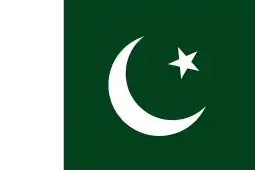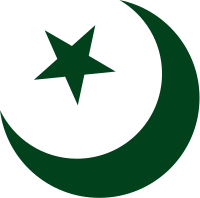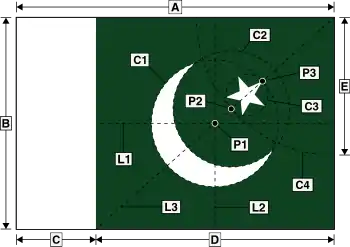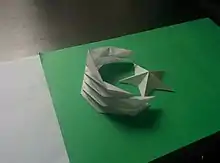Flag of Pakistan
The National Flag of Pakistan (Urdu: اسلامی جمہوریہ پاکستان کا پرچم) was adopted in its present form during a meeting of the Constituent Assembly of Pakistan on 11 August 1947, three days before the country's independence, when it was adopted by the All-India Muslim League as the official flag-to-be of the Dominion of Pakistan.[1][2][3] The flag was retained upon the establishment of a constitution in 1956, and remains in use as the national flag for the present-day Islamic Republic of Pakistan. The flag is made up of a green field with a tilted white crescent moon and five-pointed star at its centre, and a vertical white stripe at its hoist-end. Though the specific shade of green is mandated only as 'dark green',[4] its official and most consistent representation is Pakistan green, which is shaded distinctively darker.
 | |
| Name | Parc̱am-e Sitārah o-Hilāl (Flag of the Star and Crescent) |
|---|---|
| Use | National flag |
| Proportion | 2:3 |
| Adopted | 11 August 1947 |
| Design | A white star and crescent on a dark green field, with a vertical white stripe at the hoist |
| Designed by | Syed Amir-uddin Kedwaii |
| Part of a series on the |
| Culture of Pakistan |
|---|
 |
| Traditions |
| Cuisine |
| Sport |
|
The flag is notably referred to in the third verse of Pakistan's national anthem as the 'Flag of the Star and Crescent' (Persian: پرچمِ ستارہ و ہلال, رہبرِ ترقّی و کمال, romanized: Parcam-i sitārah o-hilāl, Rahbar-i taraqqī o-kamāl; transl. 'The flag of the crescent and star, Leads the way to progress and perfection,'). It is widely flown on several important days of the year, including Republic Day, Independence Day and Defence Day. It is often hoisted every morning at schools, offices and government buildings to the playing of the national anthem and lowered again before sunset. A very elaborate and charismatic flag-raising and lowering ceremony is carried out every evening by the Pakistan Rangers and their Indian Border Security Force counterparts at the Wagah–Attari border crossing between India and Pakistan, which is regularly attended by hundreds of spectators. The Government of Pakistan has formalized rules and regulations related to the flying of the national flag; it is to be displayed all day at full mast on 23 March annually to commemorate the adoption of the Lahore Resolution in 1940 and the declaration of Pakistan as an independent Islamic republic with a constitution in 1956, both of which occurred on the same day. The same regulations also apply on 14 August annually, in celebration of Pakistan's day of independence; when the country was carved out from erstwhile British India as the homeland and nation-state for the Muslims of India.
History
Indian Viceroy Louis Mountbatten's 1947 proposal for the flag of Pakistan, effectively the flag of the Muslim League but with a Union Jack in the canton was rejected by League leader Muhammad Ali Jinnah, on the grounds that he felt that a flag featuring a Christian Cross alongside the Islamic Crescent would not be accepted by the Muslims of Pakistan.[5] Before the Second World War, Muslims and Hindus lived together under various kings which they called "Raja" hence the British Raj. A number of the Muslims formed the All India Muslim League. After the Second World War, when the independence of Pakistan in 1947, the flag of the Muslim League served as the basis for the flag of Pakistan.[6]
Symbolism
The green represents the Muslim majority in Pakistan and the white stripe represents the various religious minorities. The crescent represents progress and the five-pointed star represents light and knowledge.[7] The flag symbolises Pakistan's commitment to Islam and the rights of religious minorities.[8]
Design

The official design of the national flag was adopted by the Constituent Assembly together with a definition of the features and proportions.
According to the specifications it is a dark green rectangular flag in the proportion of length [A] and width [B] as 3:2 with a white vertical bar at the mast, the green portion bearing a white crescent in the centre and a five-pointed white heraldic star. The width of the white portion [C] is one quarter the length of the flag [A], nearest the mast, so the green portion occupies the remaining three quarters [D]. Draw a diagonal L3 from the top right hand corner to the bottom left corner of the green portion. On this diagonal establish two points P1 and P2. P1 is positioned at the centre of the green portion and P2 at the intersection of the diagonal L3 and an arc C4 created from the top right hand corner equal to 13/20 the height of the flag [E]. With the centre at point P1 and a radius 3/10 the height of the flag describe the first circle C1 and with centre at point P2 and a radius 11/40 the height of the flag describe a second circle C2. The enclosures made by these two circles form the crescent. The dimensions of the five-pointed white heraldic star are determined by drawing a circle C3 with a radius 1/10 the height of the flag positioned between P2 and P3 on the diagonal L3. The circle surrounds the five points of the heraldic star and star lies with one point on the diagonal L3 at point P3 where the circle C1 intersects the diagonal L3. The flag is coloured in Pakistan green having standard RGB values (red = 0, green = 64, blue = 26) or with hex triplet #00401A or the HSV value = (h = 144, s = 100, v = 25). The left strip, the star and the crescent are painted in white. The flag is supported from left white side.
Dimensions
The Interior Ministry of Pakistan provides dimensions for flags in different circumstances:
- For ceremonial occasions: 24′ × 16′, 21′ × 14′, 18′ × 12′, 11′ × 6 2⁄3′ or 9′ × 6 1⁄4′.
- For use over buildings: 6′ × 4′ or 3′ × 2′.
- For cars: 24″ × 16″.
- For tables: 10 1⁄4″ × 8 1⁄4″.
Colour scheme
| Green | White | |
|---|---|---|
| RGB | 0/64/26 | 255/255/255 |
| Hexadecimal | #00401A | #FFFFFF |
| CMYK | 100/0/60/75 | 0/0/0/0 |
National flag protocols
 | |
| Use | Civil ensign |
|---|---|
| Proportion | 2:3 |
| Design | A red field with the national flag in the canton. |
 Variant flag of Pakistan (variants) | |
| Use | Naval ensign |
| Proportion | 1:2 |
| Design | A lengthened version of the national flag. |
- No other flag or colour must fly higher.
- When displayed or flown alongside other national flags, the National Flag must be displayed or flown at the same height as the other national flags, never lower.
- If there are two flags or colours, the National Flag should be flown at the right. In case the number of flags is more than two and odd, the National Flag should be placed in the centre, and if the number of flags is even it should be flown the first to the right of the centre.
- When displayed alongside provincial, military or corporate flags, the National Flag must be higher.
- When tied to a mast, it must be tied only at the left (at the beginning of the white bar) and left to fly freely without any obstruction.
- In a procession, the National Flag shall be carried at the centre or at the right of the procession in the line of march.
- Must not touch the ground, shoes or feet or anything unclean.
- Must never be flown in darkness.
- Must be raised at dawn and lowered at dusk (except on the Parliament of Pakistan, which is the only official building on which the flag is never lowered). When flown over the Parliament of Pakistan at night, it must always remain alit with artificial light.
- Must not be marked with anything (including words, numerals or images).
- When raising or lowering: (i) must be saluted to by all uniformed personnel, (ii) others must stand in attention.
- Must be raised or lowered ceremoniously.
- When displayed horizontally, the white strip must always be on the left, with green field on the right
- When displayed vertically, the white strip must always be at the top, with green field at the bottom.
- Must not fly or be displayed upside down or with the crescent and star facing left.
- Must not be displayed anywhere where it is likely to get dirty.
- Must not be set on fire or trampled upon.
- Must not be buried or lowered into a grave (when burying a flag-bearing casket, the National Flag must be detached from the casket and held above the grave as the casket is lowered or removed from the casket before burial).
Flag flying days
| Date | Position | Reason[9] |
|---|---|---|
| 23 March | Full-mast | Pakistan Day: Adoption of the Lahore Resolution (1940) and declaration of the Islamic Republic (1956) |
| 21 April | Half-mast | Death Anniversary of the National Poet, Muhammad Iqbal (1938) |
| 14 August | Full-mast | Independence Day (1947) |
| 11 September | Half-mast | Death Anniversary of the Father of the Nation, Muhammad Ali Jinnah (1948) |
| 9 November | Full-mast | Birthday of Muhammad Iqbal |
| 25 December | Full-mast | Birthday of Muhammad Ali Jinnah |
Use by public officials
The use of the national flag is regulated by the Pakistan Flag Rules, which were introduced in 2002 by Prime Minister Zafarullah Khan Jamali. The rules are not available online but there have been instances of misuse such as officials using flags on their vehicles when they are not entitled to do so.[10][11] The national flag is flown on the official residences and vehicles (cars, boats, planes) of the following public officials:[9]
| Office | Flag on Official Residence | Flag on Vehicles |
|---|---|---|
| The President of Pakistan[12] | ||
| The Prime Minister of Pakistan[12] | ||
| The Chairman of the Senate | ||
| The Speaker of the National Assembly | ||
| The Chief Justice of Pakistan | ||
| The Chief Justice of the Federal Shariat Court | ||
| The Governors of the Provinces | ||
| Federal Ministers (and officials entitled to the privileges of Federal Ministers) | ||
| The Chief Ministers of the Provinces | ||
| The Ministers of the Provinces | ||
| The Chief Election Commissioner | ||
| The Deputy Chairman of the Senate | ||
| The Deputy Speaker of the National Assembly | ||
| The Speakers of the Provincial Assemblies | ||
| The Chief Justices of the High Courts | ||
| Ambassadors and High Commissioners of Pakistan | ||
| Commissioners of Divisions, Deputy Commissioners and Political Agents |
Milestones
- 2017 – On 14 August, People of Balochistan hoisted a 2-mile-long flag of Pakistan in Quetta.
- 2014 – On 15 February, 29,040 people gathered in a stadium in Lahore to form the flag of Pakistan and set a new world record for forming the world's largest national flag comprising humans, which was certified by Guinness World Records.[13][14]
- 2012 – On 22 October, 24,200 people gathered in a stadium in Lahore to form the flag of Pakistan and set a new world record for forming the world's largest national flag comprising humans, which was certified by Guinness World Records.[15]
- 2004 – In August, a 340 × 510 ft (173,400 square foot) flag of Pakistan was unfurled at the National Stadium Karachi, setting the world record for the largest flag.[16][17]
- 1947 – On the night of 14 August 1947, a group of Indian Boy Scouts were in France when the news reached them that their country had become independent. Mohammad Iqbal Qureshi was one of the Muslim boy scouts who with the help of his friends turned a green turban into a Pakistani flag and unfurled it. 15 August 1947 was the first time when the Pakistani flag flew on foreign soil.

See also
References
- "Pakistan Flag specification: Resolution Passed by Constituent Assembly". Pakistan.org. Retrieved 11 December 2007.
- "Parliamentary History". National Assembly of Pakistan. Archived from the original on 24 October 2007. Retrieved 11 December 2007.
- "Parliamentary History of Pakistan" (PDF). Parliamentary Division, Government of Pakistan. Archived from the original (PDF) on 16 February 2008. Retrieved 11 December 2007.
- "Government of Pakistan: Flag description". Pakistan.gov.pk. Archived from the original on 17 January 2008. Retrieved 11 December 2007.
- Dipesh Navsaria (27 July 1996). "Indian Flag Proposals". Flags of the World. Retrieved 14 March 2020.
- "Facts about the Pakistan flag". Dawn. 12 August 2011.
- "Pakistan flag". Ministry of Information and Broadcasting, Government of Pakistan. Archived from the original on 5 March 2009. Retrieved 11 December 2007.
- "Basic Facts". Ministry of Information and Broadcasting, Government of Pakistan. Retrieved 11 December 2007.
- "Pakistan Flag". Ministry of the Interior, Government of Pakistan. Archived from the original on 14 November 2007. Retrieved 11 December 2007.
- "Secs and advisers can't fly flags on cars, homes". Daily Times of Pakistan. 21 October 2005. Retrieved 11 December 2007.
- "National flag 'not being misused'". Dawn Group of Newspapers. 13 January 2005. Retrieved 11 December 2007.
- Note:- The President and the Prime Minister may fly a personal flag in addition to the National Flag.
- "Pakistan breaks world record for largest human flag". 15 February 2014.
- "- ePaper - DAWN.COM". epaper.dawn.com.
- "Pakistan sets another record for world's largest flag". Tribune. 22 October 2012. Retrieved 18 December 2013.
- "Flag superlatives". www.crwflags.com.
- sanadeel (8 March 2008). "Worlds Largest Flag" – via YouTube.
Further reading
- Jamal Shahid (18 December 2013). "Pakistani flag hoisted on South American peak". DAWN. Retrieved 18 December 2013.
External links
- "Pakistan Flag". Ministry of the Interior, Government of Pakistan. Archived from the original on 14 November 2007. Retrieved 11 December 2007.
- Pakistan at Flags of the World